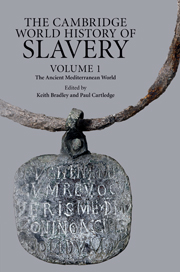Book contents
- Frontmatter
- Contents
- Series editors' introduction
- List of figures
- Acknowledgements
- Introduction
- 1 Slavery in the ancient Near East
- 2 Slaves in Greek literary culture
- 3 Classical Athens
- 4 The Helots: a contemporary review
- 5 Slavery and economy in the Greek world
- 6 The slave supply in classical Greece
- 7 Slavery and the Greek family
- 8 Resistance among chattel slaves in the classical Greek world
- 9 Archaeology and Greek slavery
- 10 Slavery in the Hellenistic world
- 11 Slavery and Roman literary culture
- 12 Slavery in the Roman Republic
- 13 Slavery Under the Principate
- 14 The Roman slave supply
- 15 Slave labour and Roman society
- 16 Slavery and the Roman family
- 17 Resisting slavery at Rome
- 18 Slavery and Roman material culture
- 19 Slavery and Roman law
- 20 Slavery and the Jews
- 21 Slavery and the rise of Christianity
- 22 Slavery in the late Roman world
- Bibliography
- General index
- Index of ancient passages cited
- Index of inscriptions and papyri
- Index of Jewish and Christian Literature Cited
1 - Slavery in the ancient Near East
Published online by Cambridge University Press: 28 September 2011
- Frontmatter
- Contents
- Series editors' introduction
- List of figures
- Acknowledgements
- Introduction
- 1 Slavery in the ancient Near East
- 2 Slaves in Greek literary culture
- 3 Classical Athens
- 4 The Helots: a contemporary review
- 5 Slavery and economy in the Greek world
- 6 The slave supply in classical Greece
- 7 Slavery and the Greek family
- 8 Resistance among chattel slaves in the classical Greek world
- 9 Archaeology and Greek slavery
- 10 Slavery in the Hellenistic world
- 11 Slavery and Roman literary culture
- 12 Slavery in the Roman Republic
- 13 Slavery Under the Principate
- 14 The Roman slave supply
- 15 Slave labour and Roman society
- 16 Slavery and the Roman family
- 17 Resisting slavery at Rome
- 18 Slavery and Roman material culture
- 19 Slavery and Roman law
- 20 Slavery and the Jews
- 21 Slavery and the rise of Christianity
- 22 Slavery in the late Roman world
- Bibliography
- General index
- Index of ancient passages cited
- Index of inscriptions and papyri
- Index of Jewish and Christian Literature Cited
Summary
DEFINING SLAVERY IN THE ANCIENT NEAR EAST
The study of the ancient Near East, the modern Middle East from Iran to Turkey to Egypt, has been pursued in the last two centuries in societies of Europe and the Americas that have themselves been mired in industrial slavery. Scholars of the ancient region have consequently been quick to point out that nowhere do we see the kind of mass exploitation that we find since the sixteenth century of our era. Some have tried to deny that there even were slaves in the ancient Near East and have suggested that we should not call some of the dependent people slaves.
It is true that there were other kinds of dependency in the ancient Near East besides slavery, and ancient law-givers and others who reflected their societies were not concerned clearly to define lowly statuses that they took for granted. But there is no question that persons could be and were bought and sold from a very early period, such transactions fitting with a traditional definition of what slavery is. Patterson (1982), however, questions whether this is sufficient. He argues that in societies with a wide range of documentation, a more general component of the lives of enslaved peoples was systematic dishonour from the enslaving group. He speaks also of natal alienation, meaning that the enslaving group went to lengths to deny the actual family relationships of the enslaved and to create a new subservient identity for them, engineering their social death to their former lives in freedom.
- Type
- Chapter
- Information
- The Cambridge World History of Slavery , pp. 4 - 21Publisher: Cambridge University PressPrint publication year: 2011
- 6
- Cited by



